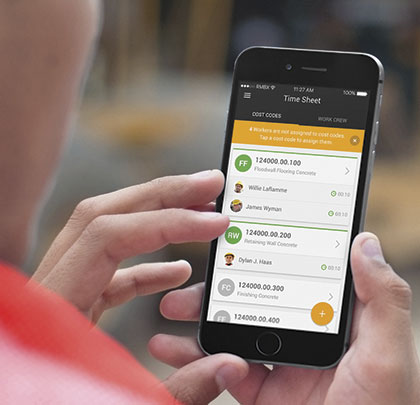Recent reports have highlighted the advantages to the construction industry of adopting technology. In their recent article “Imaging Construction’s Digital Future,” the authors from McKinsey & Company describe how construction lags behind every industry other than agriculture in terms of digitization of industry processes. They also suggested a number of areas where the industry can start to bridge the gap. In this article, Guy Skillett, head of construction for Rhumbix, a San Francisco-based technology company that develops construction productivity tools, describes how they are approaching the digitization challenge, and how companies are leveraging their construction data solutions to improve jobsite efficiency.
THE RHUMBIX BEGINNING
The genesis of Rhumbix was a large copper concentrator project in the Atacama Desert of northern Chile. The project was being constructed at 10,000 feet and in a remote location. It required a peak craft workforce of more than 7,000 workers, and the project managed timekeeping manually. Every day, 800 timecards would be submitted to the office, where a team of people would extract the data. Many days would pass before the vital information was available for analysis, whereupon it was too late to correct errors. Rhumbix CEO and co-founder, Zach Scheel, who was onsite working on productivity initiatives, could see that the data didn’t support management’s ability to measure and improve productivity. He realized that by digitizing timekeeping, and combining it with important qualitative data, such as notes and delays, projects could save a huge amount of time and create data that could actually be used to reliably measure and control the work.
While the project in Chile was unique in many ways, the use of paper-based processes is something we continue to see a lot of here in the United States. From timekeeping, daily reporting, and change management, many companies still rely on paper to record their vital field data, and for understandable reasons. Construction is a diverse and changeable process, and you need to have flexibility to record data in a way that suits your organizational workflows. Developing mobile software that is simple to use and which meets the needs of construction is challenging, and in many instances the software that has been developed to date hasn’t met the industry’s needs.
This cannot be the case moving forward. Bad data holds the industry back in many ways. Disconnected, disorganized, and siloed, inaccurate data does not support timely and effective project management, while valuable management and supervisory time is spent gathering and curating data rather than performing analysis. For construction to live up to its full potential, and meet society’s needs moving forward, it has to become more efficient and better data is the first step on the transition to a more consistent, predictable project delivery.
MEETING THE CHALLENGE
So, how has Rhumbix approached the data challenge? It learned from those early experiences with paper timecards and built its platform around the humble job hour. Time is critical for understanding where hours are spent, and where they are earned. If foremen can reliably record time against budgeted activities, and supplement this data with critical details around delays, changes, labor distribution, equipment and material usage, and production, then supervision will have much of the information they need to know as to what is happening on jobsites.
Rhumbix has been building a platform that transitions the industry from a disordered model to an ordered system, where data flows consistently and reliably from where it is created to where it is needed, delivering valuable insights and support to multiple project stakeholders along the way.
Today, foremen across the United States are using Rhumbix to complete timekeeping, cost-coding, daily reports, and quantity information in real time from the field. This vital data is immediately accessible on web-based management portals with a range of innovative dashboards. Rhumbix uses this data to automate the calculation of daily production, weekly performance, and longer-term analysis, such as forecasting and performance trends. By creating a platform that sits between the field and company’s existing systems, Rhumbix supplements existing IST tools and processes, but does not replace them, encouraging and facilitating adoption. Put simply, Rhumbix collects more data than was ever possible with paper processes, performs daily analysis, and delivers actionable insights to keep projects on track. Rhumbix believes that the construction industry does not need more data, it needs better data.
AND THE RESULTS ARE IN
So, what has Rhumbix seen with companies that have deployed its platform? Foremen save hours every week by moving to digital timecards. Payroll administrators process payroll reliably, and with zero stress, using daily timekeeping data. Companies that have never used cost codes or benchmarked construction production have created cost breakdown structures and changed the way they manage projects because they can make the transition seamlessly. Some of the largest general contractors have created innovative tools that leverage Rhumbix to benchmark production for highly specific productivity studies. In all cases, this is not by companies creating new software, but merely finding new ways to apply a simple digital tool to a challenging construction problem.
As Rhumbix continues to develop its platform, it remains excited by the opportunities that will arise as companies move away from manual processes and into the digital age. ■
About The Author: Guy Skillett is head of construction for Rhumbix, a San Francisco-based technology company that develops construction productivity tools. If you are interested in how transitioning to digital processes for your critical jobsite reporting can empower your operations, connect with Rhumbix at www.rhumbix.com.
_________________________________________________________________________
Modern Contractor Solutions – September 2016
Did you enjoy this article?
Subscribe to the FREE Digital Edition of Modern Contractor Solutions magazine.

Bridging the Gap


